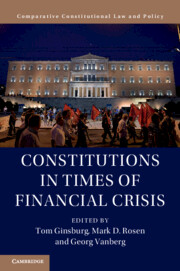Book contents
- Constitutions in Times of Financial Crisis
- Constitutions in Times of Financial Crisis
- Copyright page
- Contents
- Contributors
- Foreword
- I The Role of Constitutions in Dealing with Crises
- II Courts and Crises
- III Supranational Governance and Crisis
- IV Implementing Austerity
- V The Effect of Crises on Constitutions
- Index
V - The Effect of Crises on Constitutions
Published online by Cambridge University Press: 08 June 2019
- Constitutions in Times of Financial Crisis
- Constitutions in Times of Financial Crisis
- Copyright page
- Contents
- Contributors
- Foreword
- I The Role of Constitutions in Dealing with Crises
- II Courts and Crises
- III Supranational Governance and Crisis
- IV Implementing Austerity
- V The Effect of Crises on Constitutions
- Index
Summary
By the end of the nineteenth century the vast majority of Latin American constitutions had presidents with a relatively high degree of autonomy from congress in the operation of government, reactive legislative power, and little or no power to promote legislative change. This design has changed radically; gradually in the early decades of the twentieth century, and more rapidly after the expansion of electoral democracy in the region since the late 1970s. One salient feature of this transformation is that whereas the government powers of presidents have generally decreased, their powers in the legislative arena, in particular to promote legislative change, have increased.
- Type
- Chapter
- Information
- Constitutions in Times of Financial Crisis , pp. 283 - 326Publisher: Cambridge University PressPrint publication year: 2019

